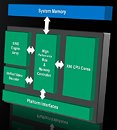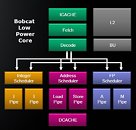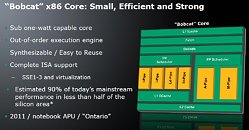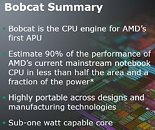- Joined
- Oct 9, 2007
- Messages
- 47,291 (7.53/day)
- Location
- Hyderabad, India
| System Name | RBMK-1000 |
|---|---|
| Processor | AMD Ryzen 7 5700G |
| Motherboard | ASUS ROG Strix B450-E Gaming |
| Cooling | DeepCool Gammax L240 V2 |
| Memory | 2x 8GB G.Skill Sniper X |
| Video Card(s) | Palit GeForce RTX 2080 SUPER GameRock |
| Storage | Western Digital Black NVMe 512GB |
| Display(s) | BenQ 1440p 60 Hz 27-inch |
| Case | Corsair Carbide 100R |
| Audio Device(s) | ASUS SupremeFX S1220A |
| Power Supply | Cooler Master MWE Gold 650W |
| Mouse | ASUS ROG Strix Impact |
| Keyboard | Gamdias Hermes E2 |
| Software | Windows 11 Pro |
AMD's answer to a lot of Intel's processors in the low-power category, be it the Core i3/i5 "Clarkdale", Core CULV, or even the Atom, seems to have finally taken shape with "Bobcat". This processor is a major design overhaul, as it integrates a number of key components, including a GPU. Since the GPU component is so complex and integrated with the rest of the processor at such a level, AMD decided to name the processor an "Accelerated Processing Unit" or APU. Beyond just driving video and 3D graphics, the GPU component of Bobcat is designed to lend a hand to the CPU cores whenever needed.
The GPU doubles up as a raw SIMD engine array that works with applications over OpenCL and ATI Stream technologies to step up performance. The "Bobcat" Fusion APU integrates x86 processor cores with a high-performance switch that doubles up as a memory controller, which connects to a SIMD engine, a UVD display controller, and platform interfaces that include connection to the southbridge chipset and display I/O.


The x86 processor cores are redesigned to cut unnecessary fat (read: caches). It features smaller, but lower latency L1 caches (32 KB L1-I and 32 KB L1-D), advanced branch prediction, full out of the order instruction execution and load/store engines, and a high-performance FPU. The processor supports the AMD64 x86-64 ISA compliant instruction set. As far as SIMD instruction sets go, it seems to have done away with SSE4a and implemented SSSE3 (Supplementary SSE3) ISA instruction set. AMD-V is present to add virtualization support.

As far as energy efficiency goes, the design allows AMD to create cores that draw less than 1W of power. The performance-watt equation is a watershed: AMD expects a chip with 90% of the performance of the current notebook CPUs to have less than half the die area, and a fraction of the power draw. The chip is designed to be deployed in a number of packages to suit various designs.
AMD is targeting the lower-mainstream and entry-level PC segments, netbooks and nettops, and cloud-computing clients with the Bobcat architecture. These chips branded under the "Fusion" brand name will be marketed in 2011.

View at TechPowerUp Main Site
The GPU doubles up as a raw SIMD engine array that works with applications over OpenCL and ATI Stream technologies to step up performance. The "Bobcat" Fusion APU integrates x86 processor cores with a high-performance switch that doubles up as a memory controller, which connects to a SIMD engine, a UVD display controller, and platform interfaces that include connection to the southbridge chipset and display I/O.


The x86 processor cores are redesigned to cut unnecessary fat (read: caches). It features smaller, but lower latency L1 caches (32 KB L1-I and 32 KB L1-D), advanced branch prediction, full out of the order instruction execution and load/store engines, and a high-performance FPU. The processor supports the AMD64 x86-64 ISA compliant instruction set. As far as SIMD instruction sets go, it seems to have done away with SSE4a and implemented SSSE3 (Supplementary SSE3) ISA instruction set. AMD-V is present to add virtualization support.

As far as energy efficiency goes, the design allows AMD to create cores that draw less than 1W of power. The performance-watt equation is a watershed: AMD expects a chip with 90% of the performance of the current notebook CPUs to have less than half the die area, and a fraction of the power draw. The chip is designed to be deployed in a number of packages to suit various designs.
AMD is targeting the lower-mainstream and entry-level PC segments, netbooks and nettops, and cloud-computing clients with the Bobcat architecture. These chips branded under the "Fusion" brand name will be marketed in 2011.

View at TechPowerUp Main Site
Last edited:



 Because there is no mention of this in the article. But thanks for the info. I can now sleep easier.
Because there is no mention of this in the article. But thanks for the info. I can now sleep easier. 
 but seriously it sounds like bobcat may be quite a nice chip for amd in the portable market as power consumption has always been one of the major negatives about amd latops, notebooks, netbooks etc.
but seriously it sounds like bobcat may be quite a nice chip for amd in the portable market as power consumption has always been one of the major negatives about amd latops, notebooks, netbooks etc.




